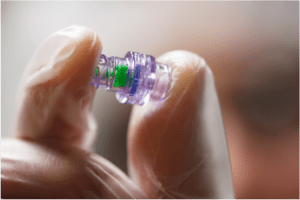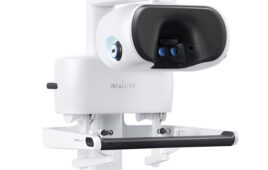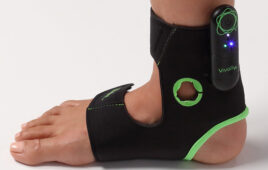
The materials of the device should enhance design freedom, promote regulatory compliance, simplify manufacturing and appeal to providers and patients by enabling ergonomic, comfortable and aesthetic solutions.
Editor’s Note: This article is written by Cheryl Goodwin, a technical business development manager at Nypro, which is a a Jabil Company.
Materials selected for use in new medical devices can have major ramifications throughout the product lifecycle, from design through testing, during regulatory approvals and production, and in the buildup to market adoption and even disposal. Ideally, materials such as plastics, composites, elastomers and metals are readily and consistently available from the supply chain. Preferably, the chosen suppliers deliver high-quality performance and safety at the target price point. And of course the materials should enhance design freedom, promote regulatory compliance, simplify manufacturing and appeal to providers and patients by enabling ergonomic, comfortable and aesthetic solutions. Checking off as many of these boxes as possible when specifying materials can make a critical difference in time to market and commercial success.
However, given the inevitable design variables and the seemingly infinite material choices available, selection can be exceptionally complicated and time-consuming. This complexity is compounded for device companies that lack deep materials expertise, and it may persuade designers to go with what they know instead of trying something better.
Several criteria should be taken into account when selecting materials. A competent design and manufacturing services partner can often save time and money by helping to avoid costly mistakes. Such partners can also suggest new solutions that address emerging trends in device design and help achieve product differentiation.
Materials selection criteria
Following are important criteria to consider when evaluating the suitability of materials for a medical device. These factors must be viewed through the lens of major trends in healthcare, from the aging of the population to the move to home-based care and the increased emphasis on preventing hospital-acquired infections (HAIs).
1. Availability
One of the baseline requirements for any material is consistently reliable availability. If quantities sufficient for current and future needs are not readily available, a new device’s time to market and sales potential could be negatively impacted. Equally important, supplies should be produced as close as possible to the device manufacturing site to avoid high shipping costs and provide just-in-time-like delivery.
Of course, availability is an umbrella term for a host of supply chain variables: financial stability and technological capabilities of the producer; existing quality systems and the supplier’s ability to provide high quality assurance; local or regional regulations; possible economic and political disruptions, and the list goes on. To succeed in this area, device companies may wish to rely on the expertise and infrastructure of a global manufacturing partner. A large, end-to-end design and manufacturer services company of diverse products typically has a strong, worldwide supply chain with trusted vendors, a wide array of rigorously tested materials and the ability to monitor and proactively manage supplier performance.

The challenge, however, is that there is a huge number of plastic chemistries and compounds, and designers may need assistance from a materials reference database or a knowledgeable partner to find the most appropriate candidates.
2. Design flexibility
Materials are instrumental to the design freedoms that drive device innovation. Plastics alone, for example, can be molded into complex shapes or consolidated from multiple parts to enable simpler, more elegant designs. Overmolding a thermoplastic elastomer onto a rigid plastic substrate can provide better grip or a more comfortable feel. Certain plastics and composites can further help designers create thinner-wall devices that combine light weight with strength.
The challenge, however, is that there is a huge number of plastic chemistries and compounds, and designers may need assistance from a materials reference database or a knowledgeable partner to find the most appropriate candidates, especially with the emergence of next-generation technologies such as conductive polymers, nanopolymers and shape memory materials. Although sticking with something tried and true may save time, it can also mean missing out on a competitive advantage or even a breakthrough design.
3. Cost per unit
Material costs are a critical aspect of any medical device. But companies need to look beyond the simple price of a plastic or metal to assess its true lifecycle costs. Different materials can raise or reduce costs by affecting downstream factors, such as:
• amount required per device, which is influenced by material density, wall thickness and part consolidation;
• additives needed or, in cases such as polymers with molded-in color, not required;
• ease and speed of manufacturing due to required secondary operations or a material’s suitability for high-volume production; and
• transport costs for shipping weight or distance.
It is important to consider how each candidate material can add or reduce the unit cost of a device throughout the full lifecycle. Sometimes a more expensive, higher-performing material can actually save money in the long run.
4. Performance properties
Central to the material selection process is matching performance capabilities to device specifications. Performance capabilities can range from mechanical properties, such as strength, flexural modulus and high temperature resistance to chemical resistance, particularly exposure to harsh antibacterial cleaners used to combat HAIs. They also include the demands of common usage scenarios, such as resistance to breaking/cracking from impact. Some materials are inherently strong, flexible or chemically resistant, while others can be enhanced with additives or reinforced with fillers or glass fiber.
5. Regulatory compliance
Although regulatory bodies certify the safety and efficacy of finished medical devices rather than their component materials, a detailed master access file for a certain material can often help smooth the road to device approval. A manufacturing partner with a dedicated regulatory practice can help device companies identify medical-grade plastics, elastomers and composites that meet U.S. FDA and USP Class VI requirements, as well as those for international regulations.
6. Biocompatibility
Biocompatibility is ultimately a function of a completed device, so it encompasses all of its components, assembly processes and overall design. However, thoughtful material selection can help ensure the overall biocompatibility of a finished product.
Each material should undergo biocompatibility assessment using characterization techniques. The complete range of testing conducted as part of a biocompatibility assessment is detailed in the standard ISO 10993-1:2009. However, in determining which specific tests to conduct, special consideration is given to how a medical device will actually be used and the degree and duration of contact between the device and the patient. This can be a complex and lengthy process, and missteps can lead to delays in the product development cycle.
An end-to-end manufacturing partner can help identify the testing required and the appropriate time in the development process to execute these tests. The timing should be considered as a factor in overall time to market, weighing it against the risk tolerance of the project. The partner of choice should also be capable of monitoring certified third-party labs used to conduct testing.
Even when materials incorporated into a medical device have been assessed for their biocompatibility, new risks can be introduced through manufacturing and post-production processes that can have an adverse effect on the device. Proper clean room assembly and hygiene processes help to lower these risks.
7. Aesthetics and usability
The trends toward home-based care delivery and consumer health monitoring devices are compelling device manufacturers to pay close attention to appearance and ease of use. Devices used by patients or family members without direct clinical supervision may require special modifications, such as improved ergonomics or grip. For example, the use of color, special effects and texture can help patients understand and follow correct usage parameters. Lightweight materials increase device portability, often without compromising strength or durability.
A manufacturing partner with experience in consumer goods, such as consumer electronics, can bring valuable expertise to materials selection for usability, aesthetics and miniaturization. Often, the consumer sector is ahead of the healthcare industry in its use of advanced material technologies. These innovations can often be transferred to medical device applications.

Manufacturing efficiency is often a core competency of large design and manufacturing services companies that produce large volumes under tight time and budget constraints.
8. Manufacturing efficiency
The manufacturing process offers significant opportunities for cost savings and productivity gains if the right materials are chosen. The ability to use high-volume and/or integrated processes, such as two-shot injection molding, can lower system costs and enable rapid scale-up. Another key opportunity involves minimizing secondary operations, such as assembly, curing, polishing and painting. For example, resins with standard or customized molded-in colors and effects are available from many suppliers.
Manufacturing efficiency is often a core competency of large design and manufacturing services companies that produce large volumes under tight time and budget constraints. They are well-versed in driving out unnecessary costs through the use of innovative materials, technologies and processes. In addition, these partners have the ability to design (or modify) products for assembly and manufacturing techniques: a key step in a product’s industrialization.
9. Sterilization and cleaning
To reduce the prevalence of HAIs, hospitals use aggressive disinfectants–such as alcohol, bleach and peroxide–as well as sterilization methods including autoclaving, gas plasma and Ethylene oxide (EtO). Repeated exposure can cause many plastic medical devices to craze or crack, lose critical properties or change color. As an alternative, metal offers excellent resistance to harsh cleaners and various sterilization techniques, but has a number of other drawbacks, such as increased weight and design restrictions. Designers seeking the middle ground can consider semi-crystalline polymers such as polypropylene, polyethylene and polyamides, which are lighter and more moldable than metals and offer better chemical resistance than amorphous polymers such as polycarbonate and acrylonitrile-butadiene-styrene.
10. Sustainability
The sustainability of medical devices comes into play primarily during design, manufacture and disposal. Material selection affects all these stages of the lifecycle. In the design phase, sustainability considerations include strategies such as the use of lower-density materials, reduced need for fillers, broader part consolidation and down-gauging. Manufacturing processes can also be tweaked to reduce energy and water use, or lower scrap generation or volatiles released from secondary painting and adhesives. So, in addition to finding the most cost-effective or highest performing material, device makers should also evaluate how it must be processed. End-of-life is another stage where materials selection can contribute to sustainability. For instance, a readily recyclable material and avoidance of problematic additives such as halogenated flame retardants to facilitate disposal.
Conclusion
Materials affect a medical device’s performance, appearance, cost, durability and sustainability and can significantly contribute to the speed of commercialization and market success. But material selection can also present huge challenges due to the sheer variety of options that must be evaluated against rigorous criteria. Designers and brand owners can streamline the selection process and reduce the risk of costly mistakes by tapping the expertise of a manufacturing partner like Nypro, a Jabil Company, with materials experience and a strong and reliable supply chain.
Nypro
www.nypro.com
Jabil Company
www.jabil.com


![A photo of the Medtronic GI Genius ColonPro polyp detection system flagging a potential sign of colon cancer during a colonoscopy. [Photo courtesy of Medtronic]](https://www.medicaldesignandoutsourcing.com/wp-content/uploads/2024/04/Medtronic-GI-Genius-doctors-268x170.jpg)

